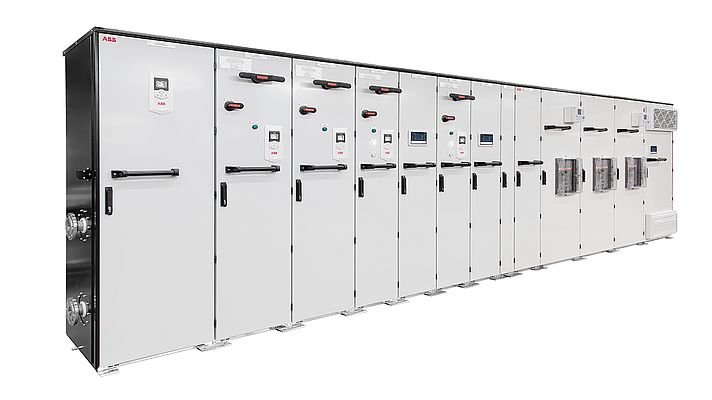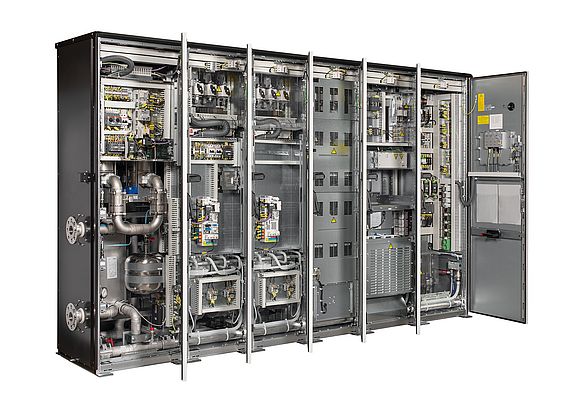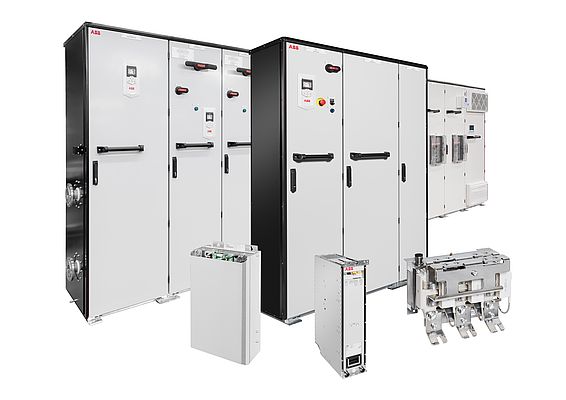Variable speed drives (VSDs) are essential to many industrial processes, enabling greater energy efficiency and more precise control of motors. Like any other type of industrial equipment, they give off heat during operation. To protect these devices from thermal damage, heat must be transferred away. In most applications, air cooling is sufficient. It relies on fans to draw in cool air from the surroundings to exhaust the heat generated by the drive. However, there are many circumstances where this is impossible or not desirable.
Many industrial environments are corrosive, dirty or hot, to name a few of the challenges. On maritime vessels, space is limited, the salty air is corrosive, and the temperature varies significantly. In oil and gas applications, meanwhile, there is a need for fire compartmentalization. Some industries require low noise levels. To operate in these environments, drives must be housed in an enclosed cabinet with no external air ventilation. This requires liquid cooling – a more efficient approach that delivers a range of benefits.
Understanding Liquid Cooling
Liquid cooling involves removing heat losses from the drive using a liquid instead of air. A standard system, typically contains two cooling circuits. In the primary cooling circuit inside the drive, circulation of the liquid enables cooling of the hot components within the drive and carries it to the drive’s primary heat exchanger.
In the primary heat exchanger, the heat is transferred to the secondary cooling circuit, which carries the warm liquid away from the drive by using, for example, process cooling water or by dissipating the losses to an external heat exchanger or even, in the case of marine vessels, directly to sea water. The heat losses can also be re-used and fed Into a recovery system for use in process heating. This is common in the pulp and paper industry and mining applications, and it reduces both consumed electricity use and CO2 emissions.
In ABB’s ACS880 drive, the liquid cooling system can dissipate 98 percent of the heat losses, enabling the drive to remain within safe operating limits. This process is highly efficient as the coolant liquid has a high heat carrying capacity – ABB’s solutions use the commercial coolant Antifrogen® L, which has a thermal conductivity 18 times greater than air. As a result, liquid-cooled (LC) drives can operate in ambient temperatures up to 55°C.
Designed for Challenging Environments
Due to the efficiency of liquid cooling, ABB’s liquid-cooled drives use totally enclosed cabinets. This makes them far more robust than air-cooled drives and eliminates common issues such as filter blockage, corrosion, and contamination, enabling longer maintenance intervals. Liquid cooling also greatly simplifies the HVAC design of the electrical room, as there is no need for ventilation and no risk of spreading dust or other particulates that can clog filters.
Cabinets and enclosures are available with high ingress protection (IP) classes. For example, ABB’s ACS880LC drive achieves IP42 as standard with an optional upgrade to IP54. Where additional protection is required, liquid-cooled modules can easily be mounted in third-party cabinets or enclosures which are designed for higher IP classes and even potentially explosive areas.
Smarter Diagnostics and Maintenance
Liquid-cooled drives, such as ABB’s ACS880LC, use a range of sensors to monitor and adapt to conditions in real time. Built-in diagnostics continually monitor all key components for hot spots and alert an operator if they exceed their operating temperature range. ABB’s drives also feature advanced diagnostics and faster and more accurate IGBT protection using a thermal model. These features limit the risk of downtime, injury and potentially expensive equipment failure.
The drives are also designed to be modular and simple to maintain. The same drive modules are used for four different drive functions: as an IGBT supply unit (ISU), inverter (INU), dynamic brake chopper (DBU) and DC-DC converter (DDC). This means that all four drive functions can use the same spare module.
Most service operations can be completed without disconnecting the coolant pipes. This saves time and removes the risk of contaminating the coolant. The use of quick connectors throughout the system also eliminates the need to disconnect cabling.
The Cost Benefits of Liquid-cooled Drives
The true and tangible value of adding a liquid-cooled drive system can be seen in several ways.
On the CAPEX side, the cost is reduced because no air conditioning devices or ventilation pipes are needed, resulting in additional footprint savings. The compactness of the LC drives also leads to smaller e-houses, which typically cost around 7,000 USD per square meter.
On the OPEX side, the cost of running the system is decreased due to lower power consumption for air conditioning, in addition to the reduction of CO2 emission fees. Furthermore, the robust structure of the LC drive system enables operators to achieve higher uptime targets in harsh conditions, which can result in significant savings in the process industry, where downtime can cost an average of 50,000 USD per hour.
Chilling Out – Liquid Cooling in Maritime Applications
Liquid-cooled drives are a key part of new electric tugboats being produced by Sanmar Shipyards. The 28.4-meter ElectRA tugs will have an energy storage capacity of 5,288 kilowatt-hours (kWh) and achieve a bollard pull of 70 tons.
The onboard liquid-cooled drives serve several essential functions, including as DC/DC converters, inverters for the motors and firefighting pumps, genset and shore rectifiers, and off-grid converters for the hotel load. The drives are ideal for use at sea because their enclosures protect them from the corrosive, salty air. Their high efficiency also enables a compact footprint for vessels with space constraints.
Across the world, liquid-cooled drives were also specified for a new 70-meter hybrid container ship with a gross tonnage of 499 tons that has been constructed in Japan. The ACS880 multidrive specified for this application includes three inverters to serve the vessel’s two propulsion motors and one thruster. It also includes a pair of grid converters for hotel loads that enable battery-powered operation.
Another benefit of specialized drives is that they contribute very little harmonics. ABB’s ACS880LC, for example, has a total harmonic distortion (THDi) of less than 3%. This is critical in applications with enclosed electrical circuits, such as on a boat or down a mine, as they suffer greatly from harmonics – which can damage equipment.
Major Benefits for Many Industries
The advantages of liquid-cooled drives are already recognized in many industries, including maritime, oil and gas, mining and tunnel boring, pulp and paper, and automotive and aerospace testing.
Increasingly, other industries are also adopting these drives because of their superior compactness, robustness, and reliability, along with their positive impact on CAPEX and OPEX. Now is the perfect time to consider liquid-cooled drives for the most demanding applications in any industry.
Roger Ekstrom, and Jarkko L. Mattila, Global Product Managers, ABB System Drives




















